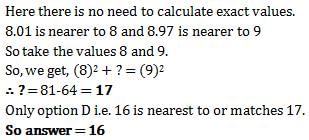Airforce X Y / Indian Navy SSR Exam > Airforce X Y / Indian Navy SSR Tests > Test: Basics of Cube & Cube Roots - Airforce X Y / Indian Navy SSR MCQ
Test: Basics of Cube & Cube Roots - Airforce X Y / Indian Navy SSR MCQ
Test Description
10 Questions MCQ Test - Test: Basics of Cube & Cube Roots
Test: Basics of Cube & Cube Roots for Airforce X Y / Indian Navy SSR 2025 is part of Airforce X Y / Indian Navy SSR preparation. The Test: Basics of Cube & Cube Roots questions and answers have been prepared
according to the Airforce X Y / Indian Navy SSR exam syllabus.The Test: Basics of Cube & Cube Roots MCQs are made for Airforce X Y / Indian Navy SSR 2025 Exam.
Find important definitions, questions, notes, meanings, examples, exercises, MCQs and online tests for Test: Basics of Cube & Cube Roots below.
Solutions of Test: Basics of Cube & Cube Roots questions in English are available as part of our course for Airforce X Y / Indian Navy SSR & Test: Basics of Cube & Cube Roots solutions in
Hindi for Airforce X Y / Indian Navy SSR course.
Download more important topics, notes, lectures and mock test series for Airforce X Y / Indian Navy SSR Exam by signing up for free. Attempt Test: Basics of Cube & Cube Roots | 10 questions in 10 minutes | Mock test for Airforce X Y / Indian Navy SSR preparation | Free important questions MCQ to study for Airforce X Y / Indian Navy SSR Exam | Download free PDF with solutions
Detailed Solution for Test: Basics of Cube & Cube Roots - Question 1
Detailed Solution for Test: Basics of Cube & Cube Roots - Question 2
Test: Basics of Cube & Cube Roots - Question 3
The cube of any multiple of 2 is always divisible by
Detailed Solution for Test: Basics of Cube & Cube Roots - Question 3
Test: Basics of Cube & Cube Roots - Question 4
What is the smallest number by which 3600 be divided to make it a perfect cube?
Detailed Solution for Test: Basics of Cube & Cube Roots - Question 4
Test: Basics of Cube & Cube Roots - Question 5
(8.01)2 + ? = (8.97)2 What will approximately come in place of question mark?
Detailed Solution for Test: Basics of Cube & Cube Roots - Question 5
Test: Basics of Cube & Cube Roots - Question 6
The smallest number by which 5400 must be multiplied so that it become a perfect cube, is
Detailed Solution for Test: Basics of Cube & Cube Roots - Question 6
Detailed Solution for Test: Basics of Cube & Cube Roots - Question 7
Test: Basics of Cube & Cube Roots - Question 8
Cube of a natural number will never end with the digit
Detailed Solution for Test: Basics of Cube & Cube Roots - Question 8
Detailed Solution for Test: Basics of Cube & Cube Roots - Question 9
Test: Basics of Cube & Cube Roots - Question 10
A cube of side n is painted green on all its sides. It is then cut into n3 identical cubes. How many of the smaller cubes will have three of its sides painted?
Detailed Solution for Test: Basics of Cube & Cube Roots - Question 10
Information about Test: Basics of Cube & Cube Roots Page
In this test you can find the Exam questions for Test: Basics of Cube & Cube Roots solved & explained in the simplest way possible.
Besides giving Questions and answers for Test: Basics of Cube & Cube Roots, EduRev gives you an ample number of Online tests for practice
Download as PDF





















